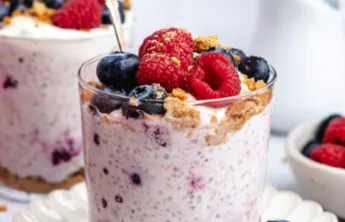A Colorful Plate Supports Your Heart Health

A Colorful Plate Supports Your Heart Health
February is American Heart Month, a time to focus on keeping your heart strong and healthy. One simple way to care for your heart is by filling your plate with a variety of colorful fruits and vegetables. But why does color matter when it comes to heart health? Let’s explore the science and practical tips for building a vibrant, heart-friendly plate. Yes, frozen fruit and vegetables count! Check out a colorful recipe at the end!
Why Color Matters for Your Heart
Each color group in fruits and vegetables provides unique nutrients that support heart health. Here’s a breakdown of how different hues can benefit your cardiovascular system:
Red (Tomatoes, Strawberries, Red Bell Peppers)
- Rich in lycopene, an antioxidant that helps reduce inflammation and lower LDL (bad) cholesterol.
- Fun Fact: A study found that consuming lycopene-rich foods reduced heart disease risk by 26% (Harvard Health, 2022).
Orange & Yellow (Carrots, Sweet Potatoes, Oranges)
- High in beta-carotene and vitamin C, which help improve blood vessel function and fight free radicals.
- These nutrients also reduce plaque buildup in the arteries.
Green (Spinach, Broccoli, Avocados)
- Packed with potassium and folate, which help regulate blood pressure and reduce the risk of heart disease.
- Dark leafy greens are also high in nitrates, which support healthy blood flow.
Blue & Purple (Blueberries, Blackberries, Eggplant)
- Contain anthocyanins, powerful antioxidants that help reduce blood pressure and improve blood vessel health.
- Did You Know? One study showed that eating blueberries daily lowered blood pressure levels and arterial stiffness (National Library of Medicine, 2021).
White & Brown (Cauliflower, Garlic, Mushrooms)
- Rich in allicin and other heart-protective compounds that support healthy cholesterol levels.
- Garlic, in particular, has been shown to reduce blood pressure.
Simple Tips for Eating the Rainbow
- Make It a Game: Challenge yourself to include at least three colors on your plate for each meal.
- Smoothie Boost: Blend spinach, blueberries, and carrots for a colorful, nutrient-packed drink.
- Salad Upgrade: Mix greens, red bell peppers, orange carrots, and purple cabbage for a vibrant side dish.
- Rainbow Roasted Veggies: Toss a variety of colorful veggies in olive oil and seasonings, then roast until caramelized.
- Choose Seasonal Winter Produce:
- Leafy Greens: Kale, Swiss chard, and spinach are often available year-round.
- Root Vegetables: Beets, radishes, and turnips store well and are typically available in winter.
- Brassicas: Cauliflower and cabbage are also in season.
- Leafy Greens: Kale, Swiss chard, and spinach are often available year-round.
- Buy Frozen Vegetables: Frozen produce is often picked at peak ripeness, retaining its nutrients. Choose:
- Spinach, beets, and cauliflower are widely available in frozen form.
- Opt for plain frozen vegetables without added sauces or salt.
- Spinach, beets, and cauliflower are widely available in frozen form.
Rainbow Roasted Veggies Recipe
Serves: 4
Prep Time: 10 minutes
Cook Time: 30 minutes
Ingredients:
- 1 cup cherry tomatoes (red)
- 1 orange bell pepper, sliced (orange)
- 1 yellow squash, sliced (yellow)
- 1 cup broccoli florets (green)
- 1 small purple onion, sliced (purple)
- 2 tbsp olive oil
- 1 tsp garlic powder
- Salt and pepper to taste
Instructions:
- Preheat oven to 400°F (200°C).
- Toss the vegetables with olive oil, garlic powder, salt, and pepper.
- Spread evenly on a baking sheet.
- Roast for 25-30 minutes or until vegetables are tender and slightly caramelized.
- Serve as a side dish or over quinoa for a complete meal.
Heart Health Benefits of Colorful Eating
- Boosts antioxidant levels to combat inflammation
- Supports healthy blood pressure and cholesterol levels
- Provides essential vitamins and minerals for heart function
Eating a rainbow isn’t just fun—it’s a simple way to protect your heart. This Heart Month, challenge yourself to fill your plate with vibrant colors that your body and heart. Focus on a new color each week for variety!
References:
Harvard Health. (2022). Lycopene and Heart Disease Prevention.
National Library of Medicine. (2021). Anthocyanin Consumption and Cardiovascular Benefits. https://pubmed.ncbi.nlm.nih.gov/36480101/
Jenny Gherau, Registered Dietitian, Diabetes Educator, Shamatha Meditation Instructor


